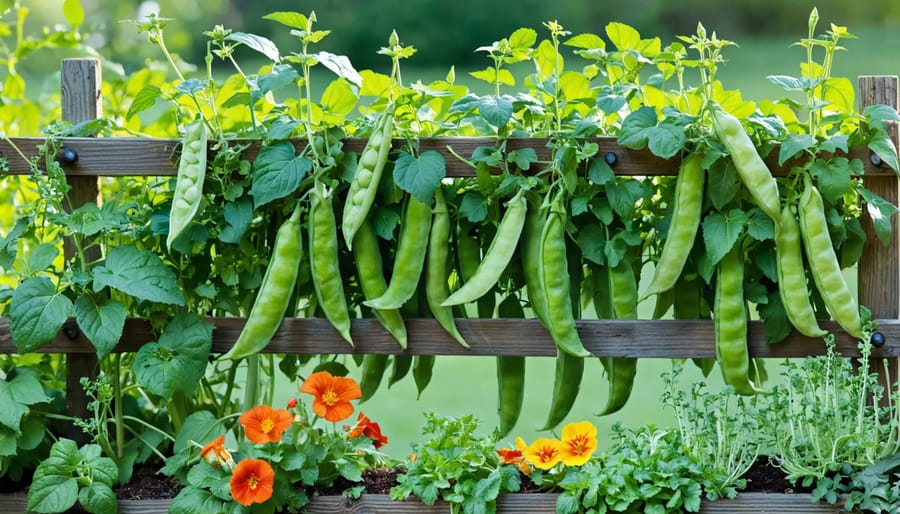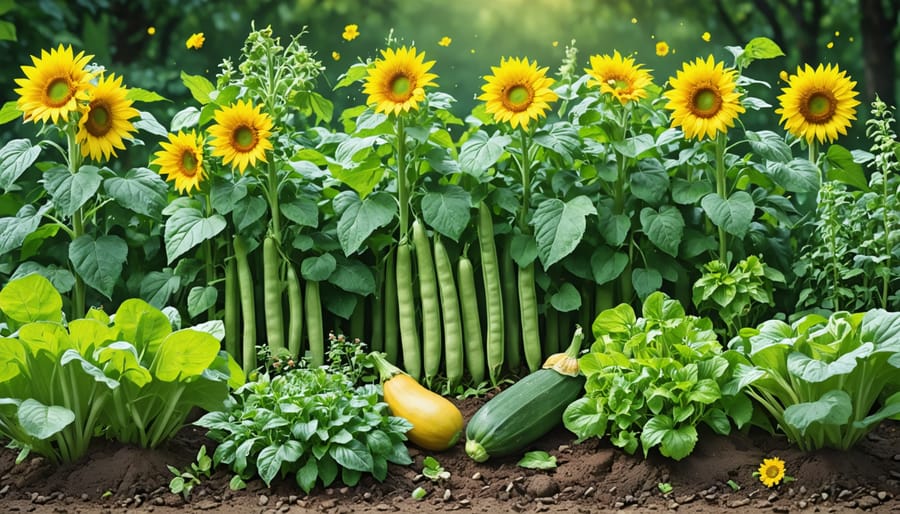Plant sugar snap peas alongside nitrogen-fixing cover crops like clover or vetch to improve soil health through companion planting and boost overall garden productivity. Interplant fragrant herbs such as mint, oregano, and thyme between pea rows to naturally deter aphids and other common pea pests while attracting beneficial pollinators. Maximize vertical growing space by combining pole varieties of sugar snap peas with sturdy, complementary climbers like nasturtiums, creating a living trellis system that enhances both yields and garden aesthetics. Position radishes and carrots near pea plantings to utilize different soil depths efficiently, allowing these root vegetables to break up compacted soil while peas enhance nitrogen levels above. This symbiotic approach transforms your garden into a thriving ecosystem where each plant contributes to the success of its neighbors.
Understanding Sugar Snap Peas’ Nutrient Needs
Key Nutrients for Healthy Pea Growth
Sugar snap peas thrive when they have access to the right nutrients in well-balanced soil. These climbing beauties are nitrogen-fixing plants, meaning they actually help enrich the soil with nitrogen. However, they still need other key nutrients to produce those crisp, sweet pods we love.
Phosphorus is essential for strong root development and pod formation. Your peas will benefit from potassium, which helps strengthen stems and improve overall plant health. Calcium plays a crucial role in cell wall development, while magnesium supports healthy leaf growth and photosynthesis.
The good news is that peas aren’t heavy feeders. A well-prepared garden bed with compost and aged manure usually provides all the nutrients they need. Adding a light layer of organic matter in spring gives them an extra boost. Remember, over-fertilizing with nitrogen can lead to lots of leafy growth but fewer peas, so maintain a balanced approach to feeding these garden favorites.
How Peas Give Back to the Soil
Sugar snap peas are nature’s little soil superheroes! These remarkable plants have a special ability to improve soil quality through a process called nitrogen fixation. Working with beneficial bacteria in their roots, peas convert nitrogen from the air into a form that plants can use, essentially creating their own natural fertilizer.
As peas grow, they store this nitrogen in special nodules on their roots. When the plants finish their growing season, they release this stored nitrogen back into the soil, making it available for nearby plants and future crops. This natural process is so effective that many gardeners plant peas specifically to enrich their soil.
Think of peas as generous neighbors who not only provide you with tasty pods but also share nutrients with plants growing nearby. This soil-enriching quality makes peas excellent companions for heavy-feeding vegetables and helps maintain your garden’s overall health naturally. Even after harvest, leaving the roots in the ground continues to benefit your soil.
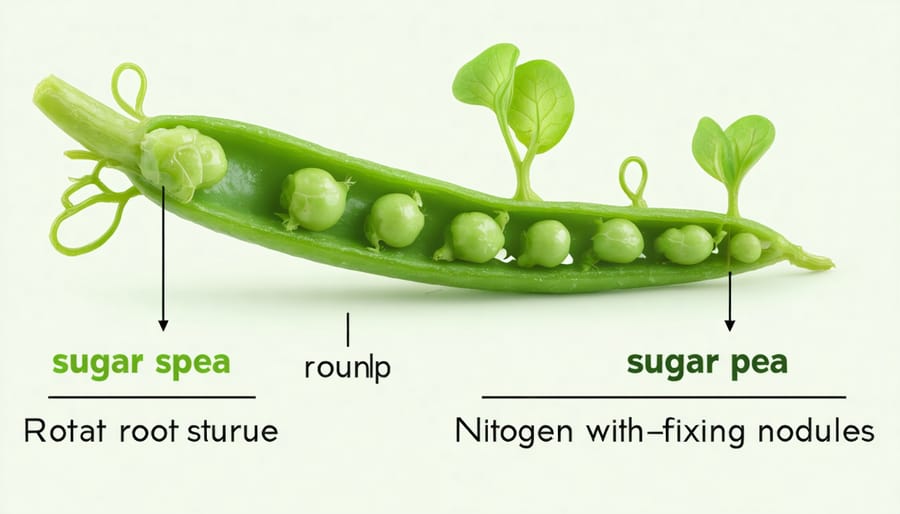
Best Nutrient-Sharing Companions for Sugar Snap Peas
Root Vegetables as Companions
Root vegetables like carrots and radishes make excellent companions for sugar snap peas, creating a harmonious underground partnership that benefits both plants. While pea roots typically occupy the top 12-18 inches of soil, carrots and radishes dive deeper, allowing them to share garden space without competing for nutrients.
Radishes are particularly beneficial as they mature quickly, usually within 30 days. By the time your peas are reaching their full growth potential, the radishes will have already been harvested, leaving behind small channels in the soil that improve aeration and water penetration for your peas. These natural pathways also make it easier for pea roots to establish themselves.
Carrots, with their longer growing season, work differently but just as effectively. Their deep root systems help break up compacted soil below the pea roots, improving drainage and soil structure. Additionally, both carrots and radishes have minimal nutrient demands compared to many other vegetables, ensuring they won’t steal essential resources from your peas.
For best results, plant radishes about 2-3 inches away from your pea trellis, and carrots about 4-6 inches away. You can succession plant radishes every two weeks for continuous harvests while your peas grow. This strategic planting not only maximizes your garden space but also creates a mutually beneficial environment where all plants can thrive.
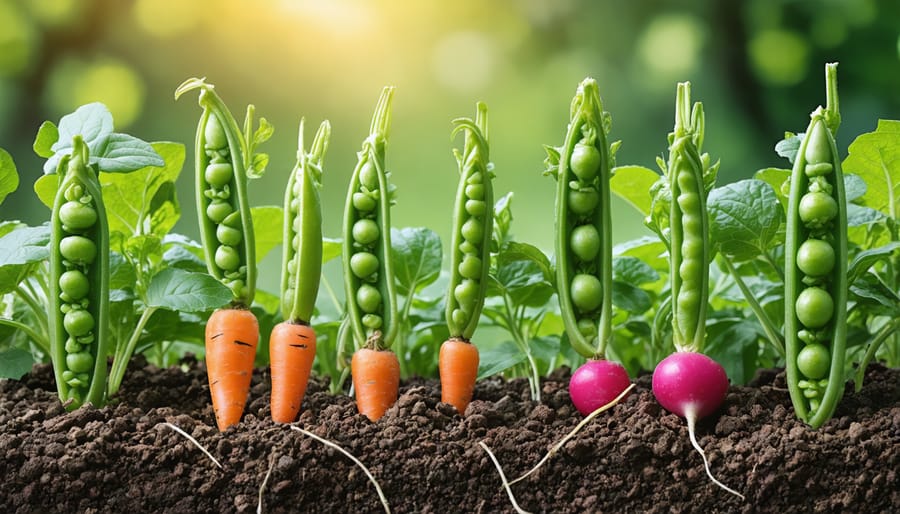
Aromatic Herbs That Support Pea Growth
Growing aromatic herbs for soil health alongside your sugar snap peas creates a delightful and beneficial partnership in your garden. Mint, basil, and other fragrant herbs act as natural pest deterrents while enhancing the growing environment for your peas.
Mint, with its spreading nature, provides excellent ground cover that helps retain soil moisture and suppress weeds around your pea plants. Its strong scent confuses and repels aphids and other common pea pests. Just remember to plant mint in containers to prevent it from taking over your garden bed.
Basil makes an excellent companion too, as it attracts beneficial pollinators while its aromatic oils help deter harmful insects. The herb’s natural compounds can even improve the flavor of nearby peas! Plant basil along the edges of your pea trellis for easy access during harvest time.
Other helpful herbs include oregano, which releases protective compounds into the soil, and thyme, which attracts predatory insects that feed on common pea pests. These low-growing herbs create a living mulch that helps maintain soil temperature and moisture levels.
For best results, plant these herbs about 12 inches away from your pea rows, allowing enough space for root development while maintaining their beneficial influence on your crop.
Leafy Greens That Thrive with Peas
Lettuce and spinach make fantastic neighbors for your sugar snap peas, creating a mutually beneficial relationship that’ll have your garden thriving. The magic happens underground, where peas perform their nitrogen-fixing miracle. As natural soil enrichers, peas work with beneficial bacteria to convert atmospheric nitrogen into a form that plants can easily use.
This natural fertilizing process is particularly beneficial for leafy greens, which are known to be heavy nitrogen feeders. When you plant lettuce or spinach near your peas, they can tap into this enriched soil, resulting in larger, healthier leaves and more vibrant growth. The best part? This partnership works throughout the growing season, as peas continuously add nitrogen to the soil.
To maximize these benefits, try planting your lettuce and spinach about 6-8 inches away from your pea trellis. This spacing gives both plants enough room to grow while still allowing the leafy greens to benefit from the nitrogen-rich soil. You can even succession plant your greens every few weeks to maintain a constant harvest.
The relationship works both ways – while your peas feed the greens, the low-growing lettuce and spinach act as living mulch, helping to keep the soil cool and moist around your pea plants’ roots. This ground cover also helps suppress weeds, making your garden maintenance easier and more efficient.
Planting Layout and Timing
Optimal Spacing Arrangements
When planning your sugar snap pea garden, proper spacing is crucial for successful companion planting. Using square foot companion planting techniques can help you maximize your growing space while ensuring each plant has room to thrive.
For sugar snap peas grown on trellises, space the plants 3 inches apart in rows, with companion plants arranged strategically around them. When pairing with carrots, plant them 4-6 inches apart in rows parallel to your peas. Radishes can be tucked between pea plants, spacing them 2-3 inches apart, as they’ll be harvested before the peas reach full size.
When combining peas with herbs, maintain a 12-inch buffer between pea rows and aromatic companions like mint or sage to prevent overcrowding. For leafy greens like spinach or lettuce, create alternating rows 8 inches apart from your pea trellis.
Avoid planting onions or garlic closer than 18 inches to your peas, as these alliums can inhibit pea growth when placed too near. Remember that sugar snap peas need vertical support, so ensure your trellis doesn’t cast excessive shade on shorter companions.
For container gardens, limit companions to one or two complementary plants per large pot, ensuring at least 12 inches of soil depth for proper root development.
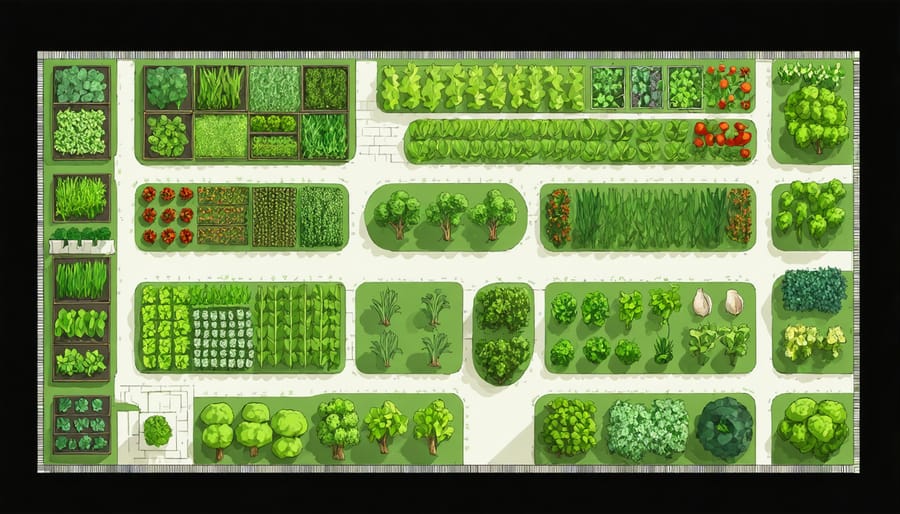
Seasonal Planting Schedule
Timing is crucial when planning your sugar snap pea companion garden. Plant your peas in early spring, about 4-6 weeks before the last frost date, or in late summer for a fall harvest. Start by sowing radishes alongside your peas, as they’ll mature quickly and help mark your pea rows while breaking up the soil.
About two weeks after planting peas, sow your carrots and spinach. These cool-season companions will develop steadily alongside your peas, making efficient use of garden space. When your peas are about 6 inches tall, plant aromatic herbs like mint and cilantro nearby – but remember to contain spreading herbs like mint in pots to prevent them from taking over.
For summer companions, wait until soil temperatures warm up (usually 2-3 weeks after pea planting) before adding heat-loving plants like bush beans. If you’re growing pole beans, plant them when peas are nearly finished producing, allowing for a smooth transition in your vertical growing space.
In zones with mild winters, you can start a second round of peas in late summer, paired with fall crops like turnips and leafy greens. This creates a continuous harvest while maintaining the beneficial relationships between companion plants throughout the growing season.
Companion planting with sugar snap peas is not just a gardening technique – it’s a way to create a thriving, interconnected garden ecosystem that benefits all your plants. As we’ve explored, pairing your peas with complementary plants like carrots, radishes, and herbs can maximize space, improve yields, and naturally deter pests without harsh chemicals.
Remember that successful companion planting starts with observation and experimentation. Don’t be afraid to try different combinations and keep notes on what works best in your garden. The beauty of this method lies in its flexibility and the opportunity to learn from each growing season.
By incorporating companion plants thoughtfully, you’ll create a more resilient garden while enjoying an abundant harvest of crisp, sweet sugar snap peas. The natural relationships between plants can help reduce your workload while improving soil health and biodiversity.
Whether you’re a seasoned gardener or just starting out, give companion planting a try this season. Your sugar snap peas – and your entire garden – will thank you for it. Start small, expand gradually, and watch as your garden transforms into a harmonious, productive space.

